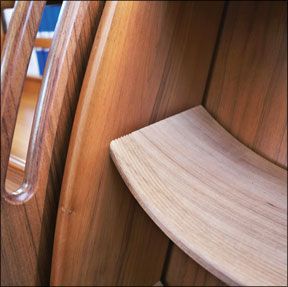What is the best substance to use on a cabin sole? Will Interlux’s Cetol products work well?
Dwain Lovett
Mystique, Sprit 28
Montserrat,
British West Indies
As with all wood-finishing techniques, there are a million different “best” coatings for a cabin sole-the answer just depends on who you ask. Advice runs the gamut-from using the same urethane clear-coat recommended for basketball courts and bowling alleys to leaving it natural.
According to Interlux (www.yachtpaint.com), its Cetol products can be used on cabin soles, but we do not recommend using them. Cetol Marine, Cetol Marine Light, and Cetol Marine Natural are relatively soft coatings and will not last long or wear well with the amount of traffic a cabin sole sees. The Cetol gloss overcoat is not as hard of a finish as most urethanes, so it would offer less protection but just as much slipperiness as a hard varnish.
What type of finish you choose greatly depends on what the sole is made of. If its a thin veneer on plywood, a hard, protective, urethane varnish is the best alternative. PS editors have had good luck with Interluxs polyurethane Goldspar Satin and Epifanes High Gloss and Wood finishes (www.epifanes.com). The products have also scored well in our past tests (Feb. 15, 2005 and August 2007).
Urethane varnishes will leave a slick, ice-rink like surface, though, so its a good idea to also use a nonskid additive.
One tried-and-true technique for this on teak-and-holly soles is to use ground walnut shell powder. (You can find it at larger boat yards, paint supply companies, and Harbor Freight.) After building up a uniform series of base coats, place -inch masking tape over the centerline of the -inch holly strips, and then mix the powder in the final coat of varnish. This results in nonskid stripes that are near in color to the teak, with enough of the sole left glossy to add a warm feel to the cabin. If you plan to add this or any other nonskid material to a finish, be sure to run it by the varnish companys technical crew before applying it.
If the boat is blessed with a solid teak sole, varnishing can be avoided. To keep the teaks natural warm look and good nonskid, use a penetrating wood sealer (Interlux or other). To maintain it, clean it with Murphys Oil Soap regularly and reapply the sealer as necessary. Every few years, a little block sanding will renew the surface.
Another product, Ultimate Sole (www.ultimatesole.com), is a dedicated cabin sole finish. Its an oil-modified urethane designed to have slip resistance and a high gloss. We have not yet tested it, so can’t recommend it, but we would appreciate feedback from any reader who has used it.


































